Table of Contents
Toggle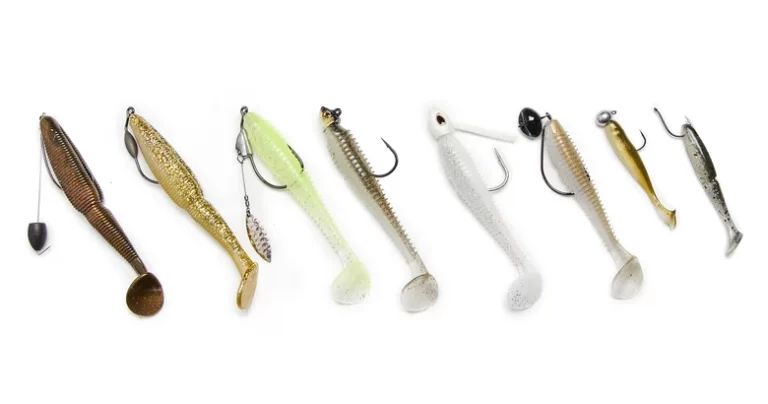
Paddle tail swimbaits are one of the most versatile baits to throw. They can be rigged tons of different ways and fished in all water conditions.
However, for such a simple bait, all the different rigging strategies might seem a bit confusing.
So here are the 5 best ways to rig paddle tail swimbaits. (I saved the best for last)
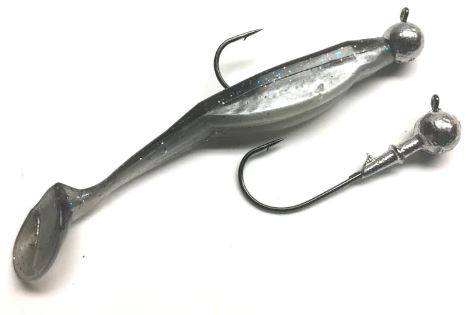
This is the most simple and straight forward rigging technique. Just take a jighead thread the bait on.
This is very simple, sleek, and effective. There are two styles of jigheads you can use for this rig.
These are the ball-head jig and the fish-head jig. I prefer using the fish-head jig because it is more realistic and creates a better overall visual presentation.
But I still throw a ball-head jig quite often. Some anglers will add a treble hook to the bottom of these to increase the hook up ratio when just slap or nip at the bait.
I rarely do this, but have had success with it, especially in colder water.
I use a simple jighead when fishing clear, open water or if I am focusing on finesse techniques.
The open hook obviously isn’t the most weedless, so I won’t use this rig when fishing around grass or structure.
This is my favorite way to rig a paddle tail swimbait when fishing clear water or open water.
It is also the best finesse rig because the sharp, open hook doesn’t require huge hooksets to penetrate the fish’s mouth.
You can use lightweight fluorocarbon and spinning gear without any trouble.
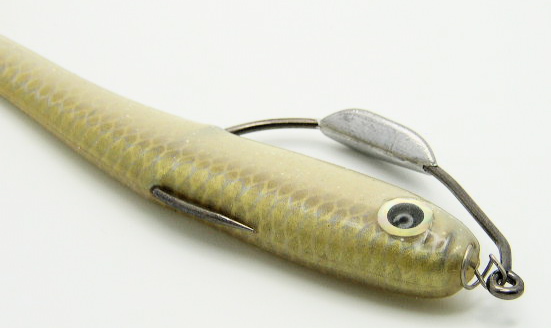
You need to be able to fish in and around cover. And it is very hard to fish a paddle tail swimbait without any added weight.
A belly weighted hook is the perfect way to rig a weedless finesse swimbait.
Make sure to get a weighted swimbait hook with a screw-lock to attach the swimbait.
Most anglers seem to prefer this rigging style over the jig head because of the added versatility and streamline profile.
Like I said, the best time to fish this rig is in and around cover. Throwing it into the grass, logs, and laydowns will catch you tons of bass.
I also love using this rig in really shallow water. Dragging it or slow rolling it on the bottom and bumping it off cover works wonders and this is the best rig for it.
Also Read: Best Weedless Bass Lures
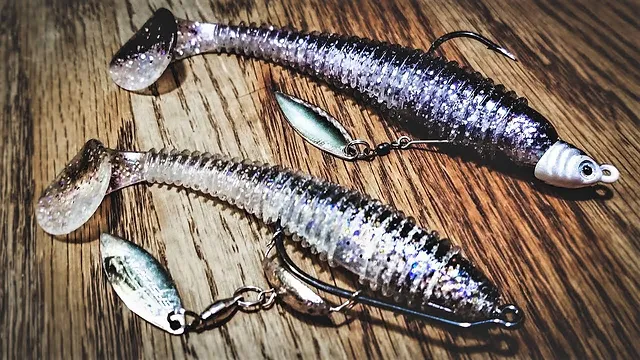
Underspin bass fishing is one of my current favorite techniques.
There are underspin options for both jigheads and wide gap hook styles. This is a much more aggressive rigging technique.
It changes the paddle tails from a finesse technique to more of a power fishing technique.
The added flash and vibration helps to get bites from aggressive, suspended fish.
I prefer the jighead underspin because it is much more compact and visually appealing.
The added blade and wire on an EDG hook looks very bulky and unnatural.
Adding the underspin is great for aggressive bass and muddier water. Flashing blades work tremendously for aggressive bass.
Paddle tail swimbaits are typically scene as a finesse bait, so they are not popular for low visibility water.
But by adding the extra flash and vibration, bass are able to easily hone in on the bait. This opens up murky water fishing opportunities.

Rigging a paddle tail swimbait on a weedless jighead is incredibly effective. This rig gives you tons of options and versatility.
It really shines around heavy cover for flipping and pitching. This rig will require some heavier gear to support it.
The thick weed guard and heavy duty hook require heavier line and rods to be able properly set the hook.
And since you will most likely be pulling bass out of cover, you also will need heavier gear to insure you don’t snap you line or lose the fish.
This presentation is very similar to swim jigs, but has a more natural and sleek profile.
You can also use an actual swim jig and use the paddle tail as a trailer if your prefer the larger presentation.
This rig is primarily a flipping rig. You will fish this the same as you would a regular bass jig.
Flipping and pitching it around lily pads, laydowns, docks, and other structure.
This will allow you to fish a swimming baitfish imitation in the nastiest of cover.
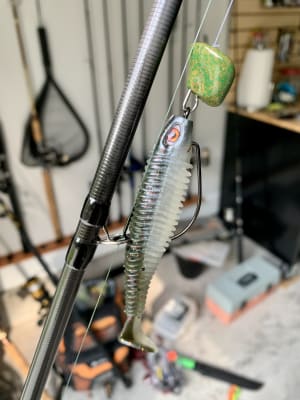
This is without a shadow of a doubt, my favorite rigging method for a paddle tail swimbait.
If you don’t know what the Headbanger Rockerhead is, it is essentially a swinging jighead that makes the bait suddenly dart to one side or another.
This creates an erratic and realistic action that triggers TONS of bites.
With some of the other rigging styles, you might have to twitch, pop, or pause the bait in order to get reaction strikes.
But the rocker head does it all for you.
Always. It is really that simple. This rigging setup is weedless so it can be fished in and around cover.
It has the best swimming action out of all the rigging setups. And also creates extra vibration, allowing it to be used in a bit dirtier water.
You can also keep the swimbait on the bottom and the swinging component of the rockerhead allows you to fish it like a shaky head.
This setup is incredibly versatile and effective in all bass fishing situations.
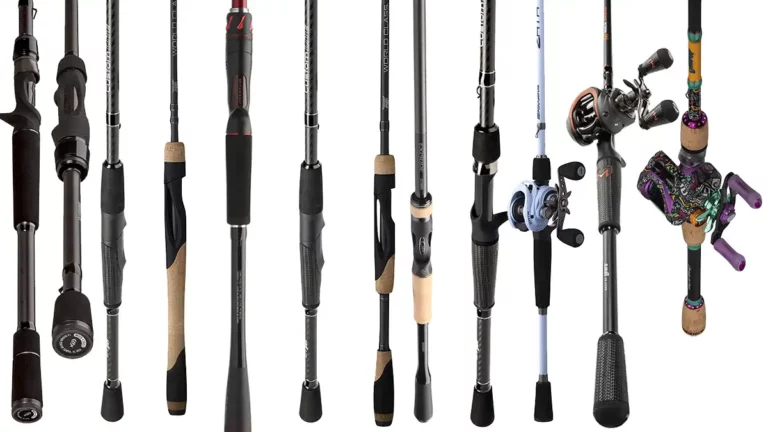
I keep the gear very simple. I use a medium to medium-heavy rod with a sensitive rod tip.
If I am fishing with a open hook jig head, I use 8-12 lb fluorocarbon line and a medium power spinning rod setup.
If I am fishing the weedless jighead for heavy cover, I use 60lb braid and a heavy power baitcasting setup.
If I am using any other rig, I use 10-17 lb fluorocarbon fishing line on a medium heavy power baitcasting setup.
You don’t need a different setup for every rigging setup. As long as your gear isn’t way too small or way too big, you will be totally fine.
Natural Movement: Paddle tails do an excellent job mimicking the lifelike swimming motion of baitfish. This realistic action is incredibly tempting for fish on the hunt.
Versatility at its Best: These soft swimbaits come in various sizes and colors, which makes them suitable for catching various fish types, from bass to walleye, and even saltwater predators like redfish and snook.
Choose Your Depth: By selecting the right jig head weight, you can control how deep the paddle tail swimbaits swim. This makes them versatile for fishing in both shallow and deep waters.
Speed Control: You can retrieve a soft swimbait at different speeds to match the fish’s mood. Slow retrieves can mimic wounded prey, while faster ones can provoke reaction strikes.
Year-Round Success: These finesse baits are effective no matter the season. They work well in spring, summer, fall, and even during the colder months.
Realisic Presentation: These swimbaits often come with realistic finishes and colors that closely resemble real prey. This lifelike appearance can fool even the fussiest of fish.
Easy Does It: Paddle tails are beginner-friendly. Whether you’re new to fishing or a seasoned pro, you can quickly get the hang of using them effectively.
Proven Results: Anglers frequently report consistent success when using paddle tail swimbaits, which makes them a dependable choice when other lures may not be doing the trick.
Also Read: Best Bluegill Swimbaits
Q1: What types of fish can be targeted with paddle tail swimbaits? A1: Paddle tail swimbaits are versatile and can be used to target a variety of predatory fish, including bass, pike, walleye, and trout.
Q2: What size and color of paddle tail swimbait should I use? A2: The size and color depend on the target species and water conditions. In clear water, natural colors often work well, while in murky water, brighter or darker colors may be more visible.
Q3: Can paddle tail swimbaits be used in both freshwater and saltwater? A3: Yes, paddle tail swimbaits are versatile and can be effective in both freshwater and saltwater environments. Choose the appropriate size and color based on the target species and conditions.
Q4: How should I retrieve a paddle tail swimbait? A4: Experiment with different retrieval speeds and pauses to imitate the movement of injured or fleeing baitfish. A steady retrieve, occasional twitches, or a stop-and-go retrieve can trigger strikes.
Q5: Are there any tips for using paddle tail swimbaits in different seasons? A5: In colder months, slow down the retrieval to match the slower metabolism of fish. In warmer months, a faster and more erratic retrieve may be effective.
Q6: Can paddle tail swimbaits be used for ice fishing? A6: Yes, smaller paddle tail swimbaits can be effective for ice fishing, especially when targeting panfish and other species. My favorite ice fishing setup for paddle tails is rigging them on a drop shot.
If you haven’t given paddle tail swimbaits a real shot, you are missing out. You can fish them in any situation with tons of success.
I never go bass fishing without a couple finesse swimbaits rigged up, and you shouldn’t either.
The 5 rigs above have given me the most success and cover all water conditions or areas you might come across.
With them in mind, get out there and catch fish and have fun!
